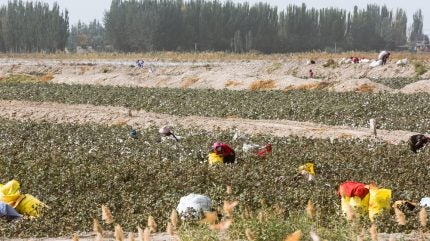
Isotopic testing on goods from Vietnam could link cotton to specific geographic areas such as Xinjiang by analysing the concentration of stable elements like carbon and hydrogen present in both the crop and the environment in which it has been grown.
In a recent study, researchers from isotope testing firm Stratum Reservoir and biotechnology company Applied DNA Sciences analysed garment samples, cotton swabs and shoes from big box retailers and ecommerce platforms, finding traces of banned Chinese cotton in 19% of a sample of merchandise selling at US and global retailers in the past year.
According to US Customs and Border Protection enforcement statistics, 2023 saw Vietnam export the greatest value of products that were denied entry to the US under the the Uyghur Forced Labor Prevention Act, which was enforced in June 2023. Products are denied entry if the companies cannot prove they do not use upstream inputs produced with alleged Xinjiang forced labour.
Why Vietnam is in spotlight over Xinjiang cotton?
Many Vietnam-based manufacturers are owned by Chinese investors with a Hinrich Foundation study released in July 2023 explaining that the “laundering” of Xinjiang cotton comes about by international intermediary manufacturers creating finished garments from semi-finished products to export globally, often using the same materials from banned Chinese suppliers. Differentiating between cotton products coming from diverse sources is challenging as they might have been blended by suppliers from China, Vietnam, Bangladesh, India, and Pakistan while being transported by sea.
“In terms of not using Xinjiang cotton, Vietnam garment makers can only afford to double down on putting their head in the sand, given that contract manufacturers normally get COD [cash on delivery] from the brand’s representative office, while FOB [free on board] manufacturers get 80% payment on proforma invoice thus are paid before shipping,” a sourcing manager at a Ho Chi Minh City-based Vietnamese fashion brand recently told Just Style anonymously.
The study’s isotope testing was conducted from February 2023 through March 2024. It found that of the products testing positive for Xinjiang cotton, 57% featured labels that claimed the origin of the merchandise was US-only. Of the items that tested positive for Xinjiang cotton, two-thirds showed that the cotton had been blended with cotton and materials from regions outside of Xinjiang.

US Tariffs are shifting - will you react or anticipate?
Don’t let policy changes catch you off guard. Stay proactive with real-time data and expert analysis.
By GlobalDataImpact of Vietnam being major supplier to key fashion brands
The Vietnamese garment sector is a major supplier to big fashion brands such as Gap, Nike and Adidas so there is strong interest from fashion retailers and logistics firms in target markets to prevent shipments from getting stuck at US ports.
Anja Padget, head of ESG (environmental, social and governance) and communications of Denmark-based apparel production software-maker Delogue, told Just Style supply chain mapping tools using blockchain technology or chain of custody documentation can assist in tracing back to ‘tier four’ suppliers, that is the raw material sources. But this type of software, examples being tex.tracer and Retraced, relies on suppliers, factories or facilities providing the correct validated data, noted Padget, while pointing out that some certification bodies have been found to not uphold the rules of international quality standards, which could help alert manufacturers to the presence of Xinjiang cotton. For example, in December 2021, the IOAS Accreditation Body alerted the worldwide textile processing standard agency for organic fibres, the Global Organic Textile Standard (GOTS), that India-based OneCert lost its GOTS accreditation with immediate effect.
“If successful it can by [following certification standards] be determined whether the raw material cotton used in a product is from China or elsewhere,” Padget said.
However, she added: “Suppliers providing the correct data and documentation is still a matter of trust, and there is therefore still not to date a bullet proof solution.”



